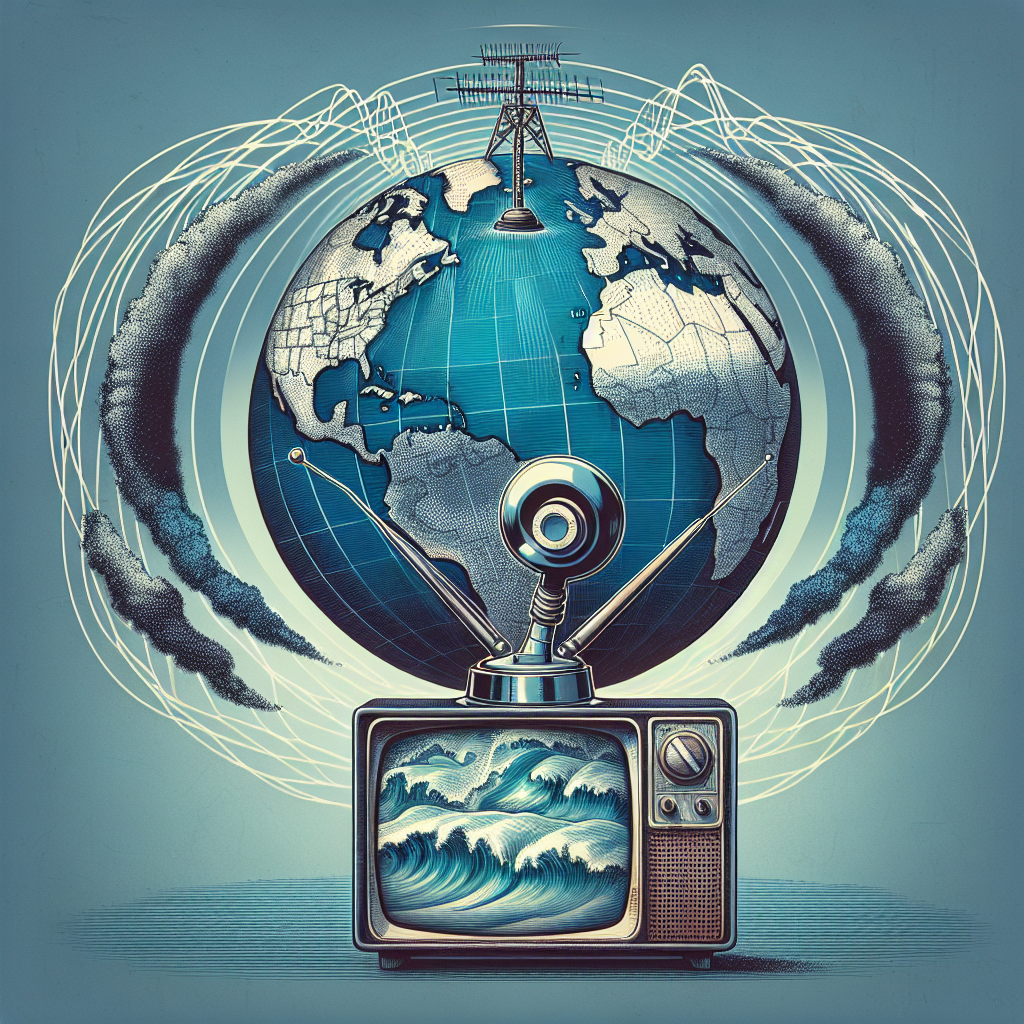In this era of interconnectedness, high-quality global TV broadcasts have become an integral part of our daily lives. From breaking news updates to captivating documentaries, these broadcasts have the power to inform, educate, and entertain audiences across the globe. This comprehensive analysis delves into the impact of these broadcasts on society, economy, and culture. Through examining the reach, influence, and production of these programs, we aim to unravel the complex dynamics at play in the world of international television. Join us on a journey to explore the far-reaching effects of high-quality global TV broadcasts in shaping our understanding of the world around us.
Understanding High-Quality Global TV Broadcasts

In the realm of television broadcasting, high-quality global TV broadcasts refer to content that is produced, packaged, and transmitted with a superior level of technical proficiency and artistic merit. These broadcasts are characterized by their exceptional visual and audio clarity, engaging storytelling, and production values that meet or exceed industry standards. When we delve into the essence of high-quality global TV broadcasts, several key components come into play:
-
Definition of high-quality TV broadcasts: High-quality TV broadcasts are those that demonstrate a commitment to excellence in all aspects of production, from scripting and casting to filming, editing, and post-production. These broadcasts prioritize the use of state-of-the-art equipment and technologies to ensure optimal audio-visual output. Moreover, they adhere to stringent quality control measures to deliver a seamless viewing experience for audiences worldwide.
-
Importance of global reach in TV broadcasting: One of the defining features of high-quality global TV broadcasts is their ability to transcend geographic and cultural boundaries to reach diverse audiences across the globe. By leveraging satellite, cable, internet, and other distribution platforms, these broadcasts have the potential to connect with viewers in different countries and regions, thereby fostering cross-cultural exchange and understanding. The global reach of high-quality TV broadcasts not only amplifies their impact but also contributes to the dissemination of diverse perspectives and narratives on a worldwide scale.
The Technological Advancements in TV Broadcasting
Transition to HD and 4K Broadcasting
he Technological Advancements in TV Broadcasting
The transition to high-definition (HD) and 4K broadcasting has revolutionized the television industry, offering viewers a more immersive and visually captivating experience. The shift from standard definition to HD content has been a game-changer, providing sharper images, vibrant colors, and enhanced clarity. With the advent of 4K resolution, which is four times the pixel density of HD, viewers can enjoy unparalleled detail and realism in their viewing experience.
Benefits of high-definition broadcasting
-
Enhanced Visual Quality: HD and 4K broadcasting deliver superior visual quality, allowing viewers to see finer details and textures that were previously not visible in standard definition broadcasts.
-
Improved Color Reproduction: The transition to HD and 4K has significantly enhanced color reproduction, providing more realistic and vivid hues that make the viewing experience more immersive.
-
Sharper Images: The higher resolution of HD and 4K broadcasts results in sharper images with greater clarity, making the viewing experience more engaging and enjoyable.
Impact on viewer experience
-
Increased Engagement: The improved visual quality of HD and 4K broadcasts captures the viewer’s attention and enhances engagement with the content being viewed.
-
Enhanced Immersion: The lifelike detail and clarity offered by high-definition broadcasting create a more immersive viewing experience, transporting viewers into the heart of the action.
-
Elevated Viewing Experience: The transition to HD and 4K broadcasting elevates the overall viewing experience, making it more enjoyable and satisfying for viewers who appreciate high-quality content.
Introduction of Digital Broadcasting
The introduction of digital broadcasting revolutionized the TV industry, bringing about significant advancements in the quality and accessibility of global TV broadcasts. This shift from analog to digital transmission has had a profound impact on viewers worldwide. Some key points to consider include:
- Advantages of digital TV broadcasting:
- Enhanced picture and sound quality: Digital broadcasting offers high-definition visuals and crystal-clear audio, providing viewers with a more immersive and engaging viewing experience.
- More efficient use of bandwidth: Digital technology allows for the transmission of multiple channels within the same bandwidth that was previously used for just one analog channel. This has led to a greater variety of programming options for audiences.
-
Interactive features: Digital TV broadcasting enables interactive services such as video-on-demand, electronic program guides, and interactive advertising, enhancing viewer engagement and customization.
-
Increased accessibility to global TV channels:
- Global reach: Digital broadcasting has facilitated the distribution of TV content to a wider global audience, transcending geographical boundaries and reaching viewers in remote locations.
- Diverse content options: With the proliferation of digital TV channels, viewers now have access to a diverse range of programming from around the world, including news, sports, entertainment, and educational content.
- Multilingual support: Digital TV broadcasts often include language options and subtitles, making it easier for viewers to access content in their preferred language and enhancing cross-cultural communication.
Overall, the introduction of digital broadcasting has had a transformative impact on the TV industry, opening up new possibilities for both broadcasters and audiences alike.

Global TV Broadcast Standards and Regulations
Overview of International Broadcasting Standards
- Importance of standardization in global TV broadcasts
- International broadcasting standards play a crucial role in ensuring consistency, quality, and compatibility of TV broadcasts across different countries and regions.
- Standardization helps in harmonizing technical specifications, content regulations, and transmission protocols, facilitating seamless communication and content exchange on a global scale.
-
Adherence to standardized broadcasting practices enhances the viewing experience for audiences worldwide and promotes a level playing field for broadcasters to compete on an international platform.
-
Role of organizations like ITU in setting broadcast standards
- The International Telecommunication Union (ITU) plays a central role in developing and maintaining global broadcasting standards through its Radiocommunication Sector (ITU-R).
- ITU-R collaborates with industry stakeholders, governments, and regulatory bodies to establish technical recommendations and guidelines for TV broadcasting, covering aspects such as spectrum allocation, signal modulation, and digital compression standards.
- By promoting the adoption of common standards, ITU aims to facilitate the interoperability of broadcast systems, promote spectrum efficiency, and ensure the smooth transition to new technologies in the broadcasting industry.
Compliance with Broadcasting Regulations
- High-quality global TV broadcasts are subject to a myriad of broadcasting regulations that govern their content, format, and distribution. These regulations vary from country to country and often aim to uphold cultural sensitivities, ethical standards, and national security concerns.
- Impact of regulations on content and quality
- Broadcasting regulations play a crucial role in shaping the content and quality of global TV broadcasts. They set parameters for permissible language, imagery, and themes, ensuring that the content aligns with societal norms and values. Compliance with these regulations is essential for maintaining the integrity and credibility of TV broadcasts.
- Regulations also impact the technical aspects of broadcasts, such as signal quality, resolution, and aspect ratio. Adhering to technical standards set by regulatory bodies ensures that viewers receive high-quality, consistent viewing experiences across different platforms and devices.
- Ensuring adherence to international broadcasting laws
- In the context of global TV broadcasts, adherence to international broadcasting laws is paramount. These laws govern cross-border transmissions, copyright protection, and the dissemination of content across diverse cultural and linguistic landscapes. Ensuring compliance with international broadcasting laws fosters global cooperation, minimizes legal disputes, and promotes the free flow of information and ideas across borders.
Challenges in Delivering High-Quality Global TV Broadcasts
Bandwidth Limitations and Streaming Quality
In the realm of high-quality global TV broadcasts, one of the primary challenges faced is the issue of bandwidth limitations and its direct impact on streaming quality. Bandwidth limitations refer to the finite capacity of data transmission channels that can restrict the amount of data that can be sent over a network within a certain period. This limitation can severely affect the quality of TV broadcasts, especially when aiming for high definition or 4K resolution.
- Effects of limited bandwidth on broadcast quality
- Limited bandwidth can result in pixelation, buffering, and overall reduced resolution of the broadcast content. This can lead to a subpar viewing experience for audiences, causing frustration and dissatisfaction.
- High-action scenes or fast-paced sequences may suffer the most from limited bandwidth, as the data-intensive nature of such content requires higher transmission speeds to maintain clarity and smooth playback.
-
Audio quality can also be compromised with limited bandwidth, leading to distortions, delays, or even complete loss of sound in extreme cases.
-
Strategies to overcome bandwidth constraints
- Content providers often employ compression techniques to reduce the size of the data being transmitted without significant loss of quality. Advanced codecs such as H.265/HEVC are commonly used to achieve efficient compression and ensure better streaming quality within limited bandwidth.
- Adaptive bitrate streaming is another effective strategy where the video quality is dynamically adjusted based on the viewer’s network conditions. This allows for seamless playback by adapting to fluctuations in available bandwidth.
- Utilizing content delivery networks (CDNs) can help in distributing the load across multiple servers geographically closer to viewers, reducing latency and improving overall streaming quality even with limited bandwidth constraints.
Cultural and Linguistic Adaptation
hallenges in Delivering High-Quality Global TV Broadcasts
Cultural sensitivity plays a pivotal role in the success of global TV broadcasts. Understanding and respecting the cultural nuances of different regions is essential to avoid inadvertently offending or alienating viewers. High-quality global TV broadcasts must navigate the delicate balance between showcasing diverse cultures authentically while also ensuring content is universally appealing.
Language localization presents a significant challenge in the delivery of global TV broadcasts. Adapting content to resonate with audiences across various linguistic backgrounds requires meticulous attention to detail. Translating dialogue accurately while capturing the nuances of language and cultural references is crucial to maintaining the integrity of the original content. Subpar localization efforts can lead to misunderstandings or disconnect with viewers, undermining the impact and effectiveness of the broadcast.
The Evolution of Global TV Carriers
Rise of Satellite TV Providers
Satellite TV providers have played a pivotal role in revolutionizing the global broadcasting landscape. With the advent of satellite technology, the reach and quality of TV broadcasts have significantly improved, leading to a host of advantages for both broadcasters and viewers alike.
Advantages of satellite TV for global broadcasting
- Global Reach: Satellite TV enables broadcasters to reach a vast global audience, transcending geographical boundaries and providing access to viewers in remote or underserved areas.
- High-Quality Transmission: Satellite technology allows for high-definition broadcasts with superior audio and visual quality, enhancing the viewing experience for audiences worldwide.
- Reliability: Satellite TV offers a reliable and stable broadcasting platform, minimizing signal disruptions and ensuring consistent delivery of content to viewers across different regions.
- Flexibility: Satellite TV providers can easily customize and tailor their programming to cater to diverse cultural preferences and linguistic differences, making it a versatile medium for global broadcasting.
- Cost-Effective: Despite the initial investment in satellite infrastructure, the cost per viewer decreases as the audience base expands, making it a cost-effective solution for reaching a large and diverse global audience.
Expansion of satellite TV services worldwide
- Market Penetration: Satellite TV providers have rapidly expanded their services to penetrate markets in various regions, offering a wide range of channels and programming options to cater to diverse audience preferences.
- Competition: The proliferation of satellite TV providers has led to increased competition in the global broadcasting industry, driving innovation and quality improvements in content delivery and viewer engagement.
- Cultural Exchange: Satellite TV broadcasts facilitate cultural exchange and cross-cultural understanding by showcasing content from different countries and regions, fostering a sense of global connectivity and shared experiences among viewers.
- Technological Advancements: Continuous advancements in satellite technology have further enhanced the capabilities of TV broadcasts, enabling features such as interactive programming, video-on-demand services, and multi-platform viewing options to meet the evolving needs of modern audiences.
Emergence of Online Streaming Platforms
The emergence of online streaming platforms has revolutionized the way global audiences consume TV content. These platforms, such as Netflix, Amazon Prime Video, and Hulu, have significantly impacted the traditional TV landscape by offering extensive libraries of content that can be accessed anytime, anywhere.
- Impact of streaming services on global TV consumption
Online streaming platforms have led to a shift in viewership habits, with many audiences opting for on-demand content over scheduled programming. This shift has not only influenced how viewers engage with TV shows and movies but has also challenged traditional TV carriers to adapt to changing consumer preferences. Additionally, streaming services have enabled viewers to access a diverse range of content from various countries, contributing to the globalization of TV consumption.
- Comparison of traditional TV carriers with online platforms

When comparing traditional TV carriers with online streaming platforms, several key differences emerge. Traditional TV carriers typically offer scheduled programming with limited on-demand options, whereas online platforms provide a vast library of content that can be accessed at any time. Furthermore, online streaming platforms often utilize algorithms to recommend personalized content to viewers, enhancing the overall viewing experience. In contrast, traditional TV carriers rely on advertising revenue and scheduled time slots to attract audiences, which may limit viewer choices and flexibility.
The Future of High-Quality Global TV Broadcasts
Integration of AI and AR Technologies
Future of High-Quality Global TV Broadcasts
The integration of artificial intelligence (AI) and augmented reality (AR) technologies marks a significant advancement in the realm of high-quality global TV broadcasts. These cutting-edge technologies are revolutionizing the way viewers engage with television content, offering a more immersive and interactive viewing experience.
- Enhancing viewer engagement through AI
By harnessing the power of AI, TV broadcasters can analyze viewer preferences and behavior patterns to tailor content recommendations and personalized viewing experiences. AI algorithms can track viewing habits, predict content preferences, and suggest relevant shows or movies, thereby enhancing viewer engagement and retention.
- Potential applications of augmented reality in TV broadcasting
Augmented reality technology overlays digital information onto the real-world environment, offering viewers a heightened sense of immersion and interactivity. In TV broadcasting, AR can be used to superimpose graphics, text, or interactive elements onto the screen, providing additional context or enhancing storytelling. Viewers can engage with AR elements by interacting with virtual objects or accessing supplementary information in real-time, creating a dynamic and captivating viewing experience.
In conclusion, the integration of AI and AR technologies in high-quality global TV broadcasts holds immense potential for transforming the way audiences consume and interact with television content. By leveraging these innovative technologies, broadcasters can deliver more personalized, engaging, and immersive viewing experiences that cater to the evolving preferences of modern viewers.
Trends in Personalized Content Delivery
High-quality global TV broadcasts are increasingly focusing on delivering personalized content to cater to the diverse preferences of global audiences. This trend underscores the importance of tailoring content to meet the specific needs and interests of viewers around the world.
Importance of tailored content for global audiences
Personalized content delivery allows TV broadcasters to enhance viewer engagement by providing relevant and targeted programming. By understanding the cultural nuances, language preferences, and viewing habits of different regions, broadcasters can create content that resonates with diverse audiences. This tailored approach not only fosters viewer loyalty but also helps attract new audiences who seek content that aligns with their interests.
Utilizing data analytics for personalized TV experiences
Data analytics play a crucial role in enabling personalized content delivery on a global scale. Broadcasters leverage advanced analytics tools to gather insights on viewer behavior, content consumption patterns, and demographic information. By analyzing this data, broadcasters can customize their programming lineup, recommend relevant shows to viewers, and optimize the overall viewing experience. This data-driven approach empowers broadcasters to deliver high-quality content that meets the evolving preferences of global audiences.
FAQs for Exploring the Impact of High-Quality Global TV Broadcasts: A Comprehensive Analysis
What are high-quality global TV broadcasts?
High-quality global TV broadcasts refer to television programs that are produced at a high standard of production value, content quality, and technical expertise. These broadcasts are typically produced by reputable media organizations and are designed to reach a global audience with informative, entertaining, and engaging content.
What is the impact of high-quality global TV broadcasts on viewers?
High-quality global TV broadcasts have a significant impact on viewers by providing them with access to diverse perspectives, cultures, and information from around the world. These broadcasts can broaden viewers’ horizons, increase their understanding of global issues, and spark discussions and conversations about important topics. Additionally, high-quality global TV broadcasts can also influence viewers’ attitudes, beliefs, and behaviors towards different cultures and societies.
How do high-quality global TV broadcasts contribute to the media landscape?
High-quality global TV broadcasts play a crucial role in shaping the media landscape by setting standards for content quality, production values, and storytelling techniques. These broadcasts often drive innovation and creativity in the industry, inspiring other media organizations to strive for excellence and push boundaries in their content creation. Additionally, high-quality global TV broadcasts can help bridge cultural divides, promote understanding and empathy among audiences, and foster a more interconnected global community.
What are some examples of high-quality global TV broadcasts?
Some examples of high-quality global TV broadcasts include popular news programs such as BBC World News, documentaries like National Geographic’s “Planet Earth,” and critically acclaimed dramas like HBO’s “Game of Thrones.” These broadcasts are known for their high production values, compelling storytelling, and ability to engage and captivate audiences from diverse backgrounds and cultures.